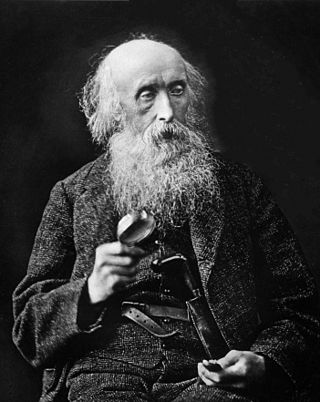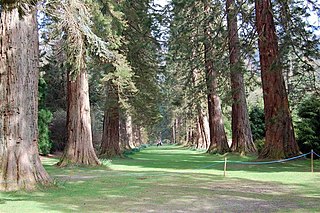Related Research Articles
Cyril Dean Darlington was an English biologist, cytologist, geneticist, and eugenicist. He discovered the mechanics of chromosomal crossover, its role in inheritance; and thus its importance to evolution. He was the Sherardian Professor of Botany at the University of Oxford from 1953 to 1971.

John Hutton Balfour was a Scottish botanist. Balfour became a Professor of Botany, first at the University of Glasgow in 1841, moving to the University of Edinburgh and also becoming the 7th Regius Keeper of the Royal Botanic Garden Edinburgh and Her Majesty's Botanist in 1845. He held these posts until his retirement in 1879. He was nicknamed Woody Fibre.

The Royal Botanic Garden Edinburgh (RBGE) is a scientific centre for the study of plants, their diversity and conservation, as well as a popular tourist attraction. Founded in 1670 as a physic garden to grow medicinal plants, today it occupies four sites across Scotland—Edinburgh, Dawyck, Logan and Benmore—each with its own specialist collection. The RBGE's living collection consists of more than 13,302 plant species, whilst the herbarium contains in excess of 3 million preserved specimens.

Benmore Botanic Garden is a large botanical garden situated in Strath Eachaig at the foot of Beinn Mhòr, on the Cowal Peninsula, in Argyll and Bute, west of Scotland. The gardens are on the west side of the A815 road from Dunoon, between the Holy Loch and Loch Eck, and include footbridges across the River Eachaig. It is one of the sites of Royal Botanic Garden Edinburgh.
Sir William Wright Smith FRS FRSE FLS VMH LLD was a Scottish botanist and horticulturalist.
The Botanical Society of Scotland (BSS) is the national learned society for botanists of Scotland. The Society's aims are to advance knowledge and appreciation of flowering and cryptogamic plants, algae and fungi. The Society's activities include lectures, symposia, field excursions, field projects and an annual Scottish Botanist's Conference, held jointly with the Botanical Society of Britain and Ireland for exchange of information between botanists working in different areas. Its publications include a twice-yearly newsletter, BSS News, and a scientific journal, Plant Ecology & Diversity. The society is closely linked to the Royal Botanic Garden Edinburgh and the Scottish universities.
Sir George Taylor, FRS FRSE FLS LLD was a Scottish botanist.

Stephen Blackmore CBE FRSE Royal Society of Biology FLS is a British botanist, who was educated at St. George's School, Hong Kong and the University of Reading where he completed his PhD in 1976 on the "Palynology and Systematics of the Cichorieae". He was elected a fellow of the Linnean Society of London in 1976. He then worked at the Royal Society of London’s Research Station on Aldabra Atoll in the Indian Ocean before being appointed Lecturer in Biology and Head of the National Herbarium and Botanic Garden at the University of Malawi. In 1980, he was appointed Head of Palynology at Natural History Museum in London and from 1990 to 1999 served there as Keeper of Botany. In 1985 he organized, together with Keith Ferguson, the Linnean Society symposium "Pollen and Spores: Form and Function" and in 1990, together with Susan Barnes, "Pollen and Spores: Patterns of Diversification". He was the 15th Regius Keeper of the Royal Botanic Garden Edinburgh from 1999 until 20 December 2013, and was appointed His Majesty's Botanist in Scotland in 2010.
John Cowan is an American musician.
William Grant Craib was a British botanist. Craib was Regius Professor of Botany at Aberdeen University and later worked at the Royal Botanic Gardens, Kew.
Noel Farnie Robertson (1923–1999) was a Scottish botanist and agriculturist who was elected a Fellow of the Royal Society of Edinburgh (FRSE).
Roland Edgar Cooper FRSE FRSGS was a British botanist and Curator of the Royal Botanic Garden Edinburgh from 1936 to 1950. Within the Gardens the Roland Edgar Cooper Collection stems from his own work. A number of species found by him bear the name Cooperi. A large number of Rhododendrons collected by Cooper continue to grow in the Gardens.
Dr Charles Edward Foister FRSE was a British botanist and plant pathologist. He was Director of Scottish Agricultural Scientific Services in Edinburgh from 1957. He specialised in lichens and fungi.
Douglas Mackay Henderson CBE FRSE FLS was a Scottish botanist, the 12th Regius Keeper of the Royal Botanic Garden Edinburgh from 1970 to 1987.

William McRae FRSE CIE was a Scottish botanist specialising in fungi and lichens. He is largely remembered for his extensive work in India.
Matthew Young Orr FRSE (1883-1953) was a 20th-century British botanist and a specialist on conifers.
Henry Marshall Steven CBE FRSE was a 20th-century Scottish forester and academic. He was Editor of "Forestry" magazine from 1926 to 1946.
Pauline May Harrison was a British protein crystallographer and professor emeritus at the University of Sheffield. She gained her chemistry degree from Somerville College, Oxford in 1948, followed by a DPhil in X-ray crystallography in 1952 supervised by Dorothy Hodgkin. After 3 years at King's College London she moved to the University of Sheffield in 1955 as a demonstrator in the Biochemistry department, obtaining an MRC grant to study the iron storage protein Ferritin, publishing preliminary X-ray diffraction data in the 1st volume of the Journal of Molecular Biology in 1959. The molecule which became her life's work. In 1978, she was awarded a personal chair and retired in 1991. In 2001 she was appointed a CBE for services to higher education.
Ronald William John Keay was a British botanist, who did much of his work in tropical Africa.
Adeline May Cowan was a Scottish botanist. She was active in India and was mainly interested in Spermatophytes. The standard author abbreviation A.M.Cowan is used to indicate this person as the author when citing a botanical name.
References
- ↑ "Cowan, John Macqueen (1892-1960) Botanist". The National Archives. Retrieved 11 September 2018.
- 1 2 Harman, Oren Solomon (2004). The Man Who Invented the Chromosone: The Life of Cyril Darlington. p. 62. ISBN 9780674013339.
- ↑ "HUH - Databases - Botanist Search". kiki.huh.harvard.edu. Retrieved 11 September 2018.
- ↑ Cowan, J. M. (1927). The forests of Kalimpong: an ecological account. The University of Edinburgh; doctoral dissertation
{{cite book}}: CS1 maint: postscript (link) - ↑ Desmond, Ray, ed. (1994). Dictionary of British and Irish Botanists and Horticulturists. CRC Press. p. 173. ISBN 9780850668438.
- ↑ "The Trees of Northern Bengal by A M. Cowan & J. M. Cowan". catalog entry, Smithsonian Libraries & Archives.
- ↑ International Who’s Who of Women, 2002
- ↑ Professor Pauline Harrison, Department of Molecular Biology and Biotechnology, Sheffield University.
- ↑ International Plant Names Index. Cowan.